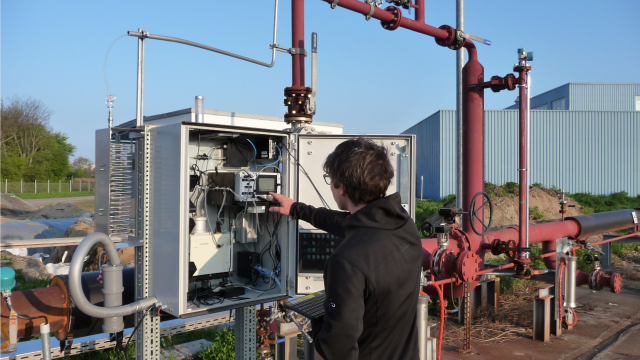
ANEMONA - New technologies for monitoring geothermal systems
Challenges in the use of deep geothermal energy
When so-called deep geothermal energy is used, hot thermal water from several thousand metres deep is transported to the earth's surface. In the above-ground part of a geothermal plant, the water is guided through a heat exchanger. The thermal water is then fed back into the ground via a reinjection well. The energy transferred in the heat exchanger is used to generate electricity or to supply district heating.
The operation of geothermal plants poses several technical challenges. On the one hand, dissolved substances, such as magnesium and calcium, also reach the surface in the thermal water conveyed. These minerals can precipitate and deposit on the walls of plant components such as pipelines and in the heat exchanger. If these deposits, also known as scale, occur on a large scale, this has an effect on the performance of the plant. For example, the heat transfer may be less effective, or the reinjection of thermal water may be endangered. On the other hand, radionuclides naturally occurring in the subsurface may accumulate in the scale. This means that plant components may become contaminated during plant operation. These must then be monitored regarding radiation protection and subsequent disposal.
In the ANEMONA research project funded by the German Federal Ministry of Economics and Energy (BMWi), experts from GRS, EnBW AG and the Geosciences Centre at the University of Göttingen have developed methods and technical systems with which these challenges can be met effectively. This makes it possible to operate geothermal power plants even more efficiently and safely in the future.
Forecasting scale formation
The chemical properties of the thermal water are decisive for the formation of scale. In particular, the pH value and the redox potential have an influence on the solubility of substances. However, the collection of these data is technically demanding. The measuring instruments used must be corrosion-resistant in contact with saline solutions and insensitive to high temperatures and pressures. GRS has therefore developed new methods to determine these parameters more reliably in thermal waters. After initial testing under laboratory conditions, the new methods were also tested in a geothermal plant during operation. With the help of the new monitoring system, the actual hydrogen ion concentration and thus the formation of scale can be predicted by the operator even more precisely.
Monitoring of NORM substances in geothermal plants
Whether and to what extent scales are formed in geothermal plants also plays an important role from a radiation protection point of view. For this reason, GRS researchers have also dealt with the measurement of radiation or natural radioactive substances in the geothermal plant. The so-called dose rate - which indicates the intensity of ionising radiation - is relevant for operational radiation protection on the one hand. On the other hand, it allows conclusions to be drawn as to which quantities of natural radionuclides have accumulated at which parts of the plant. These deposits in plant components, also known as NORM (Naturally Occurring Radioactive Materials), determine how these components must be disposed of after use.
The researchers at GRS have therefore developed a measuring system with which the occurrence of internal deposits can be documented by determining the dose rate during plant operation. As a new element of plant monitoring, the non-destructive measurement of dose rate can prove in real time the processes of scale deposition as well as the effectiveness of countermeasures. "We were surprised ourselves at how quickly and sensitively the measuring systems we developed reacted to changes in the operating mode. We were also pleased with how reliably the systems worked. Now we are looking for another facility in which we can test the systems - especially as they can be put into operation without much effort," says Dr. Henrich Meyering, member of GRS's Environmental Radioactivity Department.
In addition to measuring the dose rates, the experts also tested the use of gamma cameras. Such cameras combine conventional image recording with a measurement of gamma radiation. The measuring results are displayed in the form of coloured overlays in the photo of the measured object (see Figure 1). Numerous tests on plant components and waste packages have shown that the use of gamma cameras makes it easier to identify deposits at specific points in the sometimes-complex pipeline systems. In combination with the comparatively simple operation, the cameras thus represent a sensible supplement to the measuring methods used so far.
Determining radon content in thermal water
In addition to developing methods for determining the relevant chemical properties of thermal water, GRS researchers have also been involved in measuring radon. This radioactive noble gas is formed during the decay of uranium, which occurs in varying amounts in the geological subsoil, depending on the region. So far, no suitable methods have been available to continuously monitor the radon level in geothermal plants. This is partly due to the conditions under which the measurements have to take place there: The temperature in the pipeline system is around 120 degrees Celsius and the pressure is around 20 bar. As part of ANEMONA, GRS has now combined two methods with which the radon concentration can be continuously determined shortly downstream of the production well. During the practical test at the Bruchsal site, the new system was able to record corresponding measuring data for the first time during the ongoing operation of a geothermal plant. These data contribute to a better understanding of the geochemical properties of the thermal water reservoir at a depth of several thousand metres.